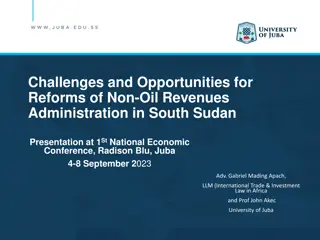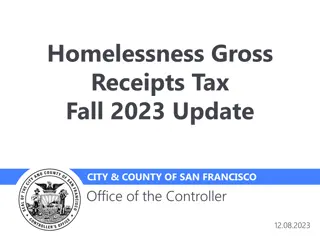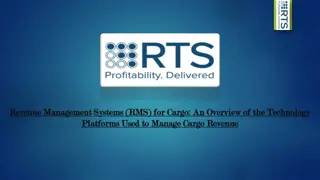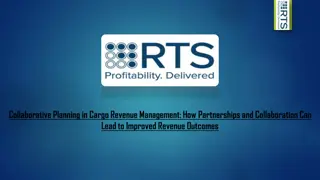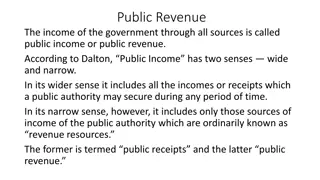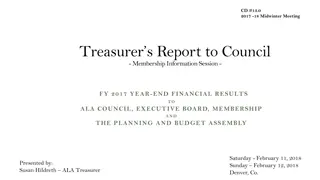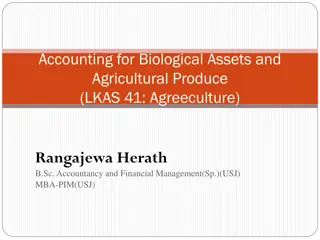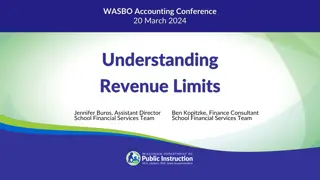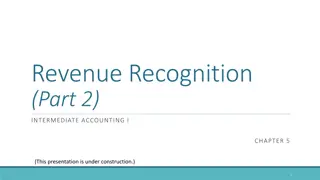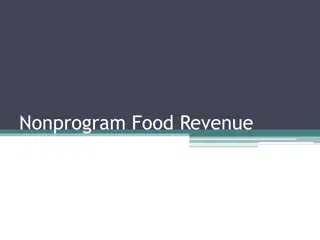Revenue Recognition Guidelines under LKAS 18
LKAS 18 provides guidelines on how to recognize revenue from various sources like sale of goods, rendering services, interest, royalties, and dividends. Revenue recognition is based on specific conditions being met, such as transfer of risks and rewards of ownership, reliable measurement of revenue, and probability of economic benefits flowing to the enterprise. The document also outlines situations where revenue recognition is not appropriate, such as when the enterprise retains significant risks of ownership.
Download Presentation

Please find below an Image/Link to download the presentation.
The content on the website is provided AS IS for your information and personal use only. It may not be sold, licensed, or shared on other websites without obtaining consent from the author.If you encounter any issues during the download, it is possible that the publisher has removed the file from their server.
You are allowed to download the files provided on this website for personal or commercial use, subject to the condition that they are used lawfully. All files are the property of their respective owners.
The content on the website is provided AS IS for your information and personal use only. It may not be sold, licensed, or shared on other websites without obtaining consent from the author.
E N D
Presentation Transcript
LKAS18: LKAS18: Revenue Revenue Rangajeewa Herath B.Sc. Accountancy and Financial Management (Sp.) (USJ), MBA- PIM(USJ) (Senior Lecturer, University of Sri Jayewardenepura)
What is revenue What is revenue It is the gross inflow of economic benefits during the period arising in the course of the ordinary activities of an enterprise when those inflows result in increases in equity, other than increases relating to contributions from equity participants. 2 2
LKAS 18 provides guidelines how to recognize revenue arising from: Sale of Goods Rendering Services Interest Royalties Dividend 3 3
Sale of Goods Revenue from the sale of goods should be recognised when all the following conditions have been satisfied: the enterprise has transferred to the buyer the significant risks and rewards of ownership of the goods; the enterprise retains neither continuing managerial involvement to the degree usually associated with ownership nor effective control over the goods sold; the amount of revenue can be measured reliably; it is probable that the economic benefits associated with the transaction will flow to the enterprise; and the costs incurred or to be incurred in respect of the transactioncan be measured reliably. 4 4
Sale of goods Sale of goods - If the enterprise retains significant risks of ownership, the transaction is not a sale and revenue is not recognised. An enterprise may retain a significant risk of ownership in a number of ways. 5 5
Examples for situation where risk is not transferred to buyer (a) when the enterprise retains an obligation for unsatisfactory performance not covered by normal warranty provisions; (b) when the receipt of the revenue from a particular sale is contingent on the derivation of revenue by the buyer from its sale of the goods; (c) when the goods are shipped subject to installation and the installation is a significant part of the contract which has not yet been completed by the enterprise; and (d) when the buyer has the right to rescind the purchase for a reason specified in the sales contract and the enterprise is uncertain about the probability of return. 6 6
Rendering of services Rendering of services When the outcome of a transaction involving the rendering of services can be estimated reliably, revenue associated with the transaction should be recognised by reference to the stage of completion of the transaction at the balance sheet date. The outcome of a transaction can be estimated reliably when all the following conditions are satisfied: 7 7
Rendering of services Rendering of services the amount of revenue can be measured reliably; it is probable that the economic benefits associated with the transaction will flow to the enterprise; the stage of completion of the transaction at the balance sheet date can be measured reliably; and the costs incurred for the transaction and the costs to complete the transaction can be measured reliably. 8 8
Interest, Royalties and Dividend Interest, Royalties and Dividend Revenue arising from the use by others of enterprise assets yielding interest, royalties and dividends should be recognised when: it is probable that the economic benefits associated with the transaction will flow to the enterprise; and the amount of the revenue can be measured reliably. 9 9
Revenue should be recognized on the following bases: interest should be recognised on a time proportion basis that takes into account the effective yield on the asset; royalties should be recognised on an accrual basis in accordance with the substance of the relevant agreement; and dividends should be recognised when the shareholder's right to receive payment is established. 10 10
Disclosure Requirement Disclosure Requirement 1. the accounting policies adopted for the recognition of revenue including the methods adopted to determine the stage of completion of transactions involving the rendering of services; 2. the amount of each significant category of revenue recognized during the period including revenue arising from: (i) the sale of goods; (ii) the rendering of services; (iii) interest; (iv) royalties; (v) dividends 11 11
Accounting Policies, Changes in Accounting Estimates and Errors (LKAS 08) 12 12
Accounting policies Accounting policies Accounting policies are the specific principles, bases, conventions, rules and practices applied by an entity in preparing and presenting financial statements. 13 13
Selection of Accounting Policies Accounting policies should be selected using the following methods. (1)Use of Accounting standard (2)Based on management Judgment 14 14
Changes in Accounting Policies An entity shall change an accounting policy only if the change: (a) is required by a Standard; or (b) results in the financial statements providing reliable and more relevant information about the effects of transactions, other events or conditions on the entity's financial position, financial performance or cash flows. 15 15
Accounting for Changes in Accounting Accounting for Changes in Accounting Policies Policies Retrospective application is applying a new accounting policy to transactions, other events and conditions as if that policy had always been applied. 16 16
Changes in Accounting Estimates Changes in Accounting Estimates Accounting Estimates Examples (1) Useful assets of an asset (2) Residual value of an asset (3) Depreciation method (4) Bad debts (5) Doubtful debts (6) Net realizable value (7) Provision for warranty (8) Provision for claim 17 17
Accounting for changes in Accounting Accounting for changes in Accounting Estimates Estimates The effect of a change in an accounting estimate shall be recognized prospectively by including it in profit or loss in: (a) the period of the change, if the change affects that period only; or (b) the period of the change and future periods, if the change affects both. 18 18
Errors Errors Prior period errors are omissions from, and misstatements in, the entity's financial statements for one or more prior periods arising from a failure to use, or misuse of, reliable information that: (a) was available when financial statements for those periods were authorized for issue; and (b) could reasonably be expected to have been obtained and taken into account in the preparation and presentation of those financial statements. 19 19
Accounting for the correction of the prior Accounting for the correction of the prior period error period error Retrospective restatement is correcting the recognition, measurement and disclosure of amounts of elements of financial statements as if a prior period error had never occurred. 20 20
Events after the Reporting Period (LKAS 10) 21 21
Events after the reporting period are divided in to two main types. Adjusting events Non-adjusting events 22 22
Adjusting Events after the Reporting Adjusting Events after the Reporting Period Period These are events that provide evidence of conditions that existed at the end of reporting period. 23 23
Examples for Adjusting events Examples for Adjusting events (1) Debtor as end of reporting period declared as bankrupt (2) Inventories recorded at cost at the end of reporting period sold subsequently at a lesser value than cost (3) Receiving the judgment of an un dicided case at end of the reporting period 24 24
Non-adjusting Events after the Reporting Period These are the events that are indicative of conditions that arose after the reporting period. 25 25
Examples for Non Examples for Non- -Adjusting events Adjusting events (1) Major purchase of PPE (2) Major destruction of PPE (3) Significant new investment made (4) Disposal of significant investment (5) Making a new share issue to public (6) Significant change in market value of investment 26 26
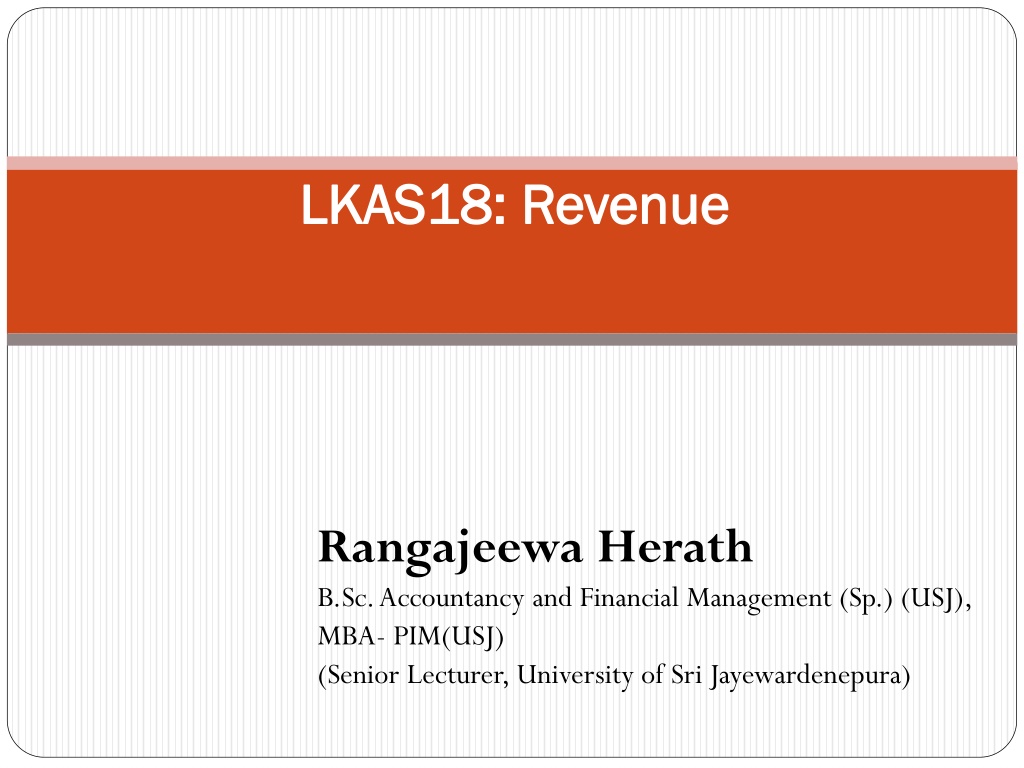
 undefined
undefined





